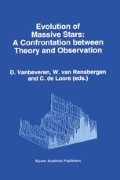Abstract
The goal of spectral synthesis is to determine the characteristics of a stellarpop-ulation (age and Initial Mass function) by comparing its observed spectrum to synthetic spectra built by adding contributions of stars (or star clusters) of various ages. When the population is young, its visible spectrum is dominated by Balmer lines. These lines have rarely been used for spectral synthesis because Balmer lines in emission are superimposed to the corresponding stellar absorption lines if there is gas ionized by the hottest young stars, a very frequent case. Still it is here that the absorption Balmer lines are the most useful. An example of a problem that can be attacked only by observing the Balmer lines is that of the possible existence of a low-mass cutoff in the IMF of an extragalactic starburst. This is a very important problem as it may affect our knowledge of star formation in general and also our ideas about evolution of galaxies. The colors of a young starburst as well as most of its spectral features are relatively unaffected by stars of a few solar masses which contribute little to the integrated luminosity and to the ionization and excitation properties. However, as the Balmer lines are much stronger for those stars than for the more massive, hotter ones, one may hope that the strength of the Balmer lines in the integrated spectrum of the starburst can give information on the presence or absence of those hot stars. It has been suggested by Augarde and Lequeux (1985) that the starburst galaxy Mkr 171 = Arp 299 = NGC 3690/IC 694 contains relatively few stars of a few solar masses as the Balmer lines in absorption seem relatively weak. Separation of the absorption from the emission component of those lines requires a good spectral resolution with a high dynamical range. Modern detectors make this possible. We have thus undertaken a program to study the Balmer lines in absorption in extragalactic starburst galaxies. This program has necessitated a new, systematic calibration of the Balmer lines equivalent widths of 70 well-classified galactic stars from spectral types O3 to G0 and luminosity classes I, III, V obtained with the same instrument and in the same conditions as the extragalactic observations (Cananzi et al.,1993,paper I). The study is limited to the Hδ and Hγ lines as they are easily accessible and less contaminated by emission lines than Hα and Hβ. We present here the model we have computed showing the variation of the equivalent widths of a star cluster as a function of the slope x, the higher mass M up , the lower mass M in f of the IMF for 2 histories of star formation: an instantaneous burst in which all stars are formed at the same time on the ZAMS and subsequently evolve in the HR diagram until 107 years and a constant star formation scenario also lasting up to 107 years. The time step used is 106 years. Because of the non-unicity of the solution inherent to spectral synthesis model, constraints like L Bol , L V, LB, LU, the number of Lyman continuum α photons and the Hβ luminosity (Osterbrock, 1989) have been synthesized as well to compare with what we observe in galaxies (Cananzi et al.,1993: paper II)
Access this chapter
Tax calculation will be finalised at checkout
Purchases are for personal use only
Preview
Unable to display preview. Download preview PDF.
References
Augarde R., Lequeux J.: 1985, A&A 147, 273
Cananzi K., Augarde R., Lequeux J.: 1993, A&AS in press, paper I
Cananzi-Mathias K.: 1993, Thèse, Université Paris VII
Cananzi K., Augarde R., Lequeux J.: 1993, A&A in preparation, paper II
Cruz-Gonzales C., Recillas-Cruz E., Costero R., Peimbert M. and Torres-Peimbert S.: 1974, In Revista Mexicana de Astronormía y Astrofísica Vol.1, p. 250
Kurucz R.L. 1991, preprint series No 3348
Leitherer C: 1990, ApJS 73, 1
Mas-Hess J.M., Kunth D.: 1991, A&A 88, 399
Osterbrock D.E.: 1989, Astrophysics of Gaseous Nebulae and Active Galactic Nuclei; University Science Books, California
Panagia J.N.L.: 1973, AJ 78, 929
Schaller G., Schaerer G., Meynet G., Maeder A.: 1992, A&AS 96, 269
Schmidt-Kaler Th.: 1982, Numerical data and Functional Relationships in Science and Technology/Landolt-Börnstein, Springer Verlag, Berlin-Heidelberg
Author information
Authors and Affiliations
Editor information
Editors and Affiliations
Rights and permissions
Copyright information
© 1994 Springer Science+Business Media Dordrecht
About this chapter
Cite this chapter
Cananzi, K., Augarde, R., Lequeux, J. (1994). Spectral Synthesis of Spectral Populations using Balmer Lines. In: Vanbeveren, D., van Rensbergen, W., de Loore, C. (eds) Evolution of Massive Stars. Springer, Dordrecht. https://doi.org/10.1007/978-94-011-1080-8_8
Download citation
DOI: https://doi.org/10.1007/978-94-011-1080-8_8
Publisher Name: Springer, Dordrecht
Print ISBN: 978-94-010-4471-4
Online ISBN: 978-94-011-1080-8
eBook Packages: Springer Book Archive

